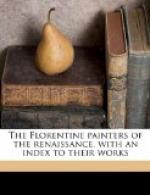Look, for instance, at Botticelli’s “Venus Rising from the Sea.” Throughout, the tactile imagination is roused to a keen activity, by itself almost as life heightening as music. But the power of music is even surpassed where, as in the goddess’ mane-like tresses of hair fluttering to the wind, not in disorderly rout but in masses yielding only after resistance, the movement is directly life-communicating. The entire picture presents us with the quintessence of all that is pleasurable to our imagination of touch and of movement. How we revel in the force and freshness of the wind, in the life of the wave! And such an appeal he always makes. His subject may be fanciful, as in the “Realm of Venus” (the “Spring"); religious, as in the Sixtine Chapel frescoes or in the “Coronation of the Virgin”; political, as in the recently discovered “Pallas Taming a Centaur”; or even crudely allegorical, as in the Louvre frescoes,—no matter how unpropitious, how abstract the idea, the vivid appeal to our tactile sense, the life-communicating movement is always there. Indeed, at times it seems that the less artistic the theme, the more artistic the fulfilment, the painter being impelled to give the utmost values of touch and movement to just those figures which are liable to be read off as mere empty symbols. Thus, on the figure representing political disorder—the Centaur—in the “Pallas,” Botticelli has lavished his most intimate gifts. He constructs the torso and flanks in such a way that every line, every indentation, every boss appeals so vividly to the sense of touch that our fingers feel as if they had everywhere been in contact with his body, while his face gives to a still heightened degree this convincing sense of reality, every line functioning perfectly for the osseous structure of brow, nose, and cheeks. As to the hair—imagine shapes having the supreme life of line you may see in the contours of licking flames, and yet possessed of all the plasticity of something which caresses the hand that models it to its own desire!




